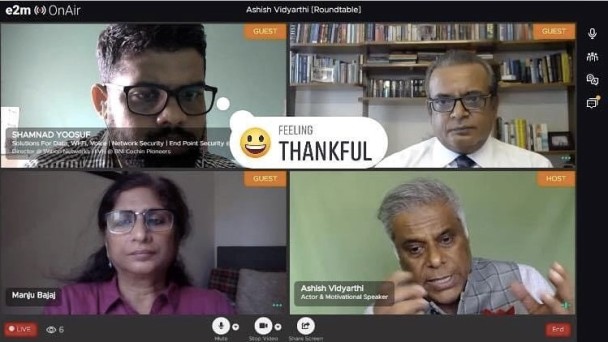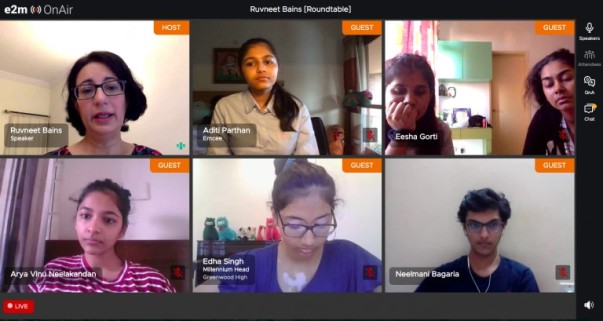While we are still working on facing the pandemic, we have surely implemented steps to effectively go about our daily lives both personal and professional by taking leverage of the virtual world. Here are the best practice steps to run events virtually, either it is a small in-company meeting or a large community event.
The Virtual Impact
Of late, more and more professional organizations are making the move to a strongly technology-assisted virtual platform for most of their functions and activities. A major area where this shift is visible is in the field of conferences, meetings which can holistically be clubbed into the category of events. Although this may seem like a rather recent development, the fact is that virtual events started off nearly two decades ago.

Hosting a virtual event has an umpteen number of advantages both direct as well as indirect. The most notable indirect impact they make is on your carbon footprint. The more direct advantages include higher levels of accessibility, convenience, and the ability to have a much larger attendance as the confines of the physical area are out of the question.
As an extension of the last aspect, you also have the added boon of being able to invite a relevant audience, regardless of their size, to also view/participate in the discussion if you wish to allow them. The scope of a virtual event can include multiple formats such as tutorials, webinars, interviews, conferences, trade shows, exhibitions, remote team meetings, live occasions to name a few.
Adding to that, with the various technological resources available out there in the form of applications, platforms, and websites, you have the ability to showcase a very vast variety of content that will do wonders in marketing your business effectively. Keeping this in view, we’ll cover some essential tips that will help you organize a successful virtual event along with some notable examples in the industry. So let’s get started.
8 best practices to run a successful virtual event
1. Chart a Course
While this point may sound rather obvious, it will come to you as quite a pleasant surprise that many organizations seem to miss out on various key aspects under this category. Proper pre-planning is super important before deciding to host a virtual event and should certainly be the first step should you decide to conduct one.
Make sure you have given a sufficient amount of thought regarding all the What, Why, Where, and How aspects that concern the event. This will help you stay aligned with the core objective of hosting the event to achieve a particular target. Some of the questions you need to keep in mind could include:
- What is the purpose of hosting the event? Fundraising or Creating Awareness or Educating your Audience?
- Who do you want the content to appeal to? People of a particular age group or people with a particular preference?
- What metrics are you targeting? Better brand reach or more sales?
- Will you be partnering with external organizations?
- What platform will the event be hosted on? Social Media or a Standalone Platform?
- Will it require special access or be open to the public?
- What is the target goal of the campaign? Overall profits or more inbound leads?
2. Know your Audience
Let’s get this straight, the sole purpose of hosting a virtual event can be entirely defined by the target audience. This aspect commences in the planning stage itself and should definitely be a part of every decision you take following that. Make sure that you get as much information as possible about your core audience through surveys, forms, etc.
Know what their preferences are, what domain interests them the most, how acquainted there are with your products etc. Build a strong profile of your target audience and keep them in consideration at all times before making any decisions pertaining to your event.
3. Choose the right event format

As we mentioned before, there are a plethora of format and platform permutations that you can go for when it comes to hosting a virtual event. Hence you should choose the most appropriate theme that fits your requirements and objectives. As an example, if you wish to educate your audience about a particular topic or concept, it makes more sense to have a breakout session with a subject matter expert rather than hosting a conference consisting of 10 or more people.
The latter format would be more suited for a discussion or summarization of a topic. Education/Topic Discussion related events also work well with a one-on-one format. A keynote speaker is best suited for a product or service introduction.
4. Choose the right virtual event platform

We are living in an age where technology is booming at the highest rate in the history of mankind. Sadly, this makes things a little confusing, as well as there, are too many choices to think about and choose for your purpose. As for the virtual event hosting platforms, the primary segregation between them is in the form of standalone event-specific platforms like e2m live and social media platforms like Facebook Live, Twitter Live, etc.
A social media platform is better when you have a strong organic following and wish to host a more informal event. With an integrated event platform capable of running both traditional, virtual, and hybrid events, you also have the option to customize the interface a bit which you don’t with a social media platform.
5. Marketing and Promotion
Like every other aspect of the business world, marketing and promotion constitute an extremely crucial component of your virtual event. Even if you have a strong organic following, it is still recommended that you go all out concerning your marketing efforts. Your best companion for marketing an event is undoubtedly social media. Get creative with your posts and promotion material and highlight your event’s USPs, noteworthy points, information about your speakers, how it will benefit your audience, and so on.
Also, it is important to choose the right platform for promoting different components. Some types of promotions may be better suited for LinkedIn such as a personalized invite. A generic paid ad might work out better on Facebook where you will have a larger reach.
Lastly, work towards creating a necessary level of hype for the event. An ideal time to start with hyping an event is in the 14-20 days period before the event is set to commence. You can include some modern social media tools such as countdown timers to further boost your efforts. It also helps if you can get your key speakers to make a post or video describing the event on their social media profiles which is definitely a very effective method to reach out to their followers. Brand your virtual event/conference platform to your branding style. See how BCRF has branded its recent virtual fundraiser using e2m On-Air.
6. Be Ready for Glitches & Live Support from Event Platform
Just because your event is going to take place on a digital virtual platform doesn’t mean that it’s fully protected from a technical snag. The component that should be most looked after is your internet connection. It’s a good practice to thoroughly look after the bandwidth, speeds, site accessibility multiple times before the event is set to start to ensure everything is working as it is supposed to. The next most crucial components to look after are your hardware peripherals which cover speakers, mics, cameras, etc.
It won’t hurt to have a backup device for each of them in the event that any of them decide to give way while your event is taking place. Lastly, have a clear set of instructions on how to join the event for your external participants and visitors. Keep a list of common troubleshooting topics such that they can easily fix any troubles they face if they do. If you are able to allocate a person to solely look after such concerns, even better. Try to look for an event vendor that provides live support for your participants via multiple communication methods such as social media, chat windows, email, or a custom plugin within the event platform itself.
7. Emphasise on Accessibility and Appearance
You could very easily be misled into believing that since you are hosting a virtual event you need not focus on the location where you will be hosting. While it is true that you need not ensure it always takes place at your office premises depending on the type of event, you still need to work on the aesthetic characteristics of the environment you will be working in.
It is imperative that you always shoot in a clean, clutter-free environment with a preferably plain backdrop. Ensure that there aren’t too many external disturbances either like construction work or traffic which may hamper your audio.
Coming to the accessibility aspect, ensure that all the fonts you use are clear, crisp and just the right size for best readability. You can also incorporate your video with text captions, descriptions, and footnotes wherever necessary.
8. Engage your Audience
 With a virtual event, there’s a lot you can do to engage your audience in comparison to a physical event. If you are hosting a lengthy event with a continuous monologue, it can indeed get a little cumbersome for everyone to keep their attention retained towards you. Through the course of your event, you can incorporate several interactive sessions like live polls, quizzes, and keep your audience engaged in actively participating in your event.
With a virtual event, there’s a lot you can do to engage your audience in comparison to a physical event. If you are hosting a lengthy event with a continuous monologue, it can indeed get a little cumbersome for everyone to keep their attention retained towards you. Through the course of your event, you can incorporate several interactive sessions like live polls, quizzes, and keep your audience engaged in actively participating in your event.
Incorporating certain gamification elements like leaderboards can do even more wonders. While it may not be a very large incentive, the competitive spirit of humans is certainly something that will give an extra push of motivation for them to perform.
A few examples of highly successful Virtual Events
1. BCRF Virtual Fundraiser
The BCRF recently held a one of a kind virtual fundraiser, the “Hot Pink Evening”. Till this year it was a star-packed, glam-filled gala which is also their flagship annual event. However, due to the presence of the Covid-19 pandemic, its execution seemed very sketchy for 2020. Thus they opted to host a virtual gala using the e2m OnAir platform. It consisted of a very organized approach consisting of a well-designed virtual lobby, a dedicated personalized registration page, and so on.
The celebrity guests included Elizabeth Hurley, Sir Elton John, and a few more each with their own inspirational words for the crowd to hear. Despite the unconventional format, the 2020 edition of Hot Pink Evening managed to raise in excess of $5.2 million with more than 1200 registrants, making for a thoroughly successful evening.

2. BNI Cochin Annual Award Function
The global networking expert based out of Kerala, BNI was in quite a dilemma on how to host its signature annual award ceremony. With the strict pandemic guidelines in order, they went ahead with a virtual setup utilizing the capabilities of the e2m OnAir Platform. The event platform was up and away in under 3 weeks of development.
It boasted of a comprehensive simulated virtual lobby to recreate the feeling of an actual event floor with a detailed itinerary for easy navigation. The highlights included a special round table featuring guest actor and motivational speaker Ashish Vidyarthi. The net attendance exceeded 900 participants with nearly 23 speakers and 21 exhibitors.

3. Millenium 2020, Greenwood High International School
Greenwood High International School is one of the most prestigious educational institutions in Bengaluru. For the 2020 edition of their traditional intra-school event, Millennium, they opted for a slightly different approach using the e2m OnAir virtual platform. They incorporated the event with highly interactive Live Streaming windows, Q&A sessions, Roundtable Rooms, and Live Chat Sessions.
The students got to interact with professionals across the country from a myriad of industries and learn quite a few valuable lessons. Around 350 attendees came for the event and the students thoroughly enjoyed the delightful interactions they took part in while also adhering to the strict social distancing norms.


